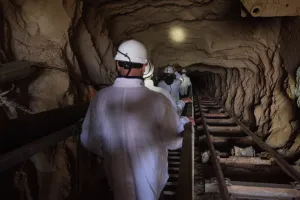How do you deal with US President Donald Trump? I have a plan. Hold on to your hats. It’s a biggie. Try not to fall off your chair. South Africa should … wait for it … leverage its mining industry! There. Shocker.
The technique is called (and I’m mentioning this specifically for the benefit of ANC policymakers, who have for decades been degrading the South African mining industry) playing to your strengths. It works like a bomb, as any Australian will tell you. In business and, as it happens, international economics, the trick is to discover your competitive advantage and exploit it. That is how to succeed. I feel like I shouldn’t need to say this, but given the gradual destruction of the South African mining industry over the past 30 years, perhaps I do.
Anyway, I’m thinking in particular about rare earth metals. Rare earth metals are delightful for all kinds of reasons, but to my sardonic brain they are wonderful because they are not rare (some are more abundant than gold) and they are not, strictly speaking, earth. They are metals, which is a relief.
Rare earth metals consist of 17 elements on the periodic table called the lanthanides – the 15 from lanthanum (La) to lutetium (Lu), plus scandium (Sc) and yttrium (Y) – which are chemically similar and often found in the same ore deposits. I mean, just the names. How do you even pronounce “yttrium”?
The big utility of rare earth metals is that they are essential to modern technology because of their unique magnetic, luminescent and electrochemical properties. They are used in clean-energy generation in wind turbines (neodymium, dysprosium); electric vehicles through batteries and magnets; consumer electronics, mostly smartphones; defence systems, including radar; jet engines and lasers; and healthcare applications such as MRI machines and cancer treatments.
And guess who does a lot of rare earth metals mining? China, obviously, accounts for about 70% of global production. More importantly, it handles 85% of refining, which is expensive and complicated. The other producers are the US, Myanmar, Australia, Nigeria and Thailand, but their quantities are minuscule compared with China.
But if you could get it right, what an enormous leverage you would have. Both the US and the EU have labelled rare earth metals as vital for national security and energy transition. It even came up in Ukraine’s negotiations with the Trump administration about a peace deal for Russia. If it works for them, might it not work for South Africa?
So, where is South Africa with its vast and extraordinary geological resources in all of this? Well, would you believe, basically nowhere.
South Africa does have a very old rare earth metals mine, a place called Steenkampskraal mine, which is really, seriously, in the middle of nowhere. It’s in the northern part of the Western Cape, about 71km from Vanrhynsdorp, and it makes one spectacular boast: it reportedly contains rare earth oxides with grades of up to 14%-18%, which is exceptionally high compared with global averages.
The mine was for just over a decade actually operated by Anglo American, but my friends in the mining industry tell me it has two problems. The first is that the total size of the resource is not huge: the currently explored ore body is about 87,000 tons of Total Rare Earth Oxides, which is equivalent to about a quarter of Chinese annual production. One of the truisms of the mining industry is this: big mines = big problem. Small mines = big problem.
The other issue is that in the mining industry there is always an interplay between grade and margin. Although the mine has high grades, about 8.68% (some of the Chinese mines have a grade of about 0.3%), a lot depends on the cost of extraction. Or in other words, the margin. In this case, the mining process is probably going to be difficult and separating the ores is complicated, too. It’s not impossible, it’s just difficult.
Yet, the concept of improving the mining industry as a defence against a Trumpist world is not a terrible one.
There is another interesting rare earth project in which is actually a recycling project near Palabowa. That is doubly useful because it extracts rare earths from phosphogypsum, which is a mildly radioactive byproduct of the phosphate fertiliser industry. There are groundwater risks from phosphogypsum, but it does contain uranium and thorium. Mining experts say there is a good chance this project gets off the ground.
South Africa’s mining industry, controversial as it is, has always been its avenue to development and economic prowess. Rare earths might not be the right path, but there is no doubt that economic durability will be a crucial factor, not only for its economic benefits, but also for national security in the years to come. DM
This post first appeared in the Daily Maverick. To signup for Daily Maverick's other fabulous newsletters, click below.
Please do forward this post to anyone who might be interested, and by all means ask them to include their email below to become a 💥 free 💥 subscriber. Till next time.



Join the conversation